what are the bases and letter used to represent each base in dna.
Chapter 9: Introduction to Molecular Biology
9.i The Structure of DNA
Learning Objectives
By the end of this department, you will be able to:
- Describe the structure of Deoxyribonucleic acid
- Draw how eukaryotic and prokaryotic Deoxyribonucleic acid is arranged in the cell
In the 1950s, Francis Crick and James Watson worked together at the Academy of Cambridge, England, to determine the structure of Dna. Other scientists, such as Linus Pauling and Maurice Wilkins, were also actively exploring this field. Pauling had discovered the secondary structure of proteins using 10-ray crystallography. X-ray crystallography is a method for investigating molecular structure by observing the patterns formed by X-rays shot through a crystal of the substance. The patterns give important data about the structure of the molecule of involvement. In Wilkins' lab, researcher Rosalind Franklin was using X-ray crystallography to sympathise the structure of DNA. Watson and Crick were able to piece together the puzzle of the Deoxyribonucleic acid molecule using Franklin's information (Effigy 9.2). Watson and Crick also had key pieces of information available from other researchers such as Chargaff'due south rules. Chargaff had shown that of the four kinds of monomers (nucleotides) present in a Deoxyribonucleic acid molecule, two types were always nowadays in equal amounts and the remaining two types were also always present in equal amounts. This meant they were always paired in some way. In 1962, James Watson, Francis Crick, and Maurice Wilkins were awarded the Nobel Prize in Medicine for their work in determining the construction of Dna.
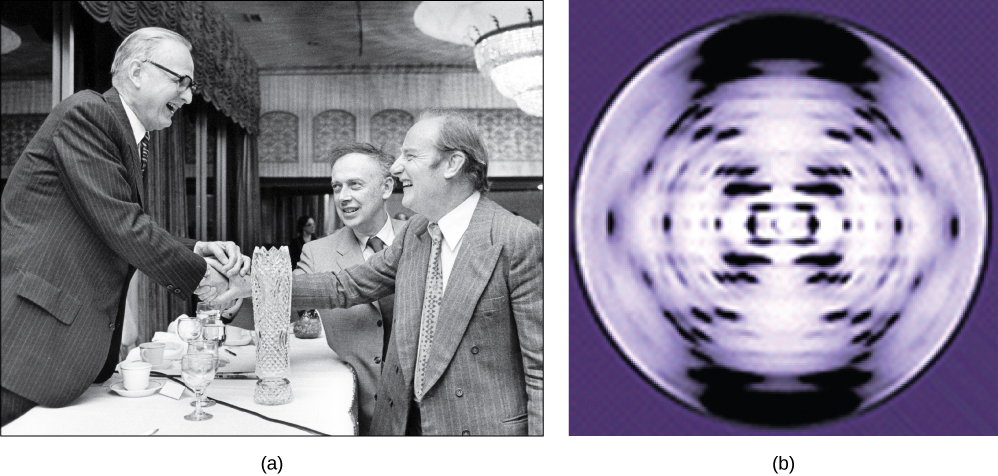
Now let's consider the structure of the two types of nucleic acids, deoxyribonucleic acrid (DNA) and ribonucleic acid (RNA). The edifice blocks of DNA are nucleotides, which are made upwards of three parts: a deoxyribose (5-carbon sugar), a phosphate grouping, and a nitrogenous base (Figure 9.iii). There are four types of nitrogenous bases in Dna. Adenine (A) and guanine (G) are double-ringed purines, and cytosine (C) and thymine (T) are smaller, unmarried-ringed pyrimidines. The nucleotide is named according to the nitrogenous base information technology contains.
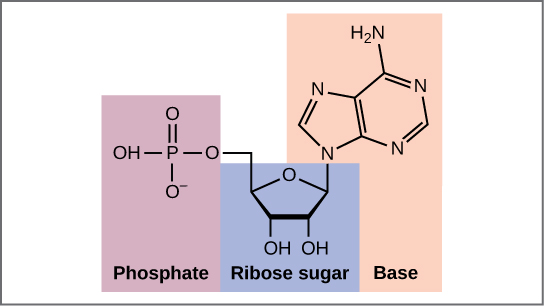
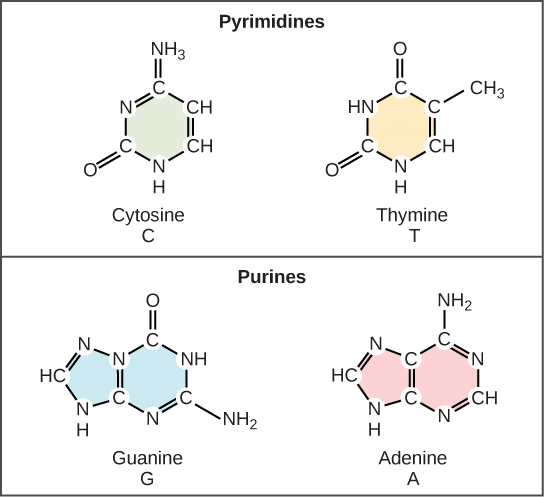
The phosphate group of one nucleotide bonds covalently with the sugar molecule of the next nucleotide, and and so on, forming a long polymer of nucleotide monomers. The carbohydrate–phosphate groups line upwardly in a "backbone" for each single strand of DNA, and the nucleotide bases stick out from this backbone. The carbon atoms of the five-carbon carbohydrate are numbered clockwise from the oxygen as i′, 2′, iii′, 4′, and five′ (1′ is read as "i prime number"). The phosphate group is attached to the v′ carbon of one nucleotide and the three′ carbon of the next nucleotide. In its natural country, each DNA molecule is actually equanimous of 2 unmarried strands held together along their length with hydrogen bonds between the bases.
Watson and Crick proposed that the DNA is made upward of two strands that are twisted around each other to course a correct-handed helix, called a double helix. Base-pairing takes identify between a purine and pyrimidine: namely, A pairs with T, and G pairs with C. In other words, adenine and thymine are complementary base of operations pairs, and cytosine and guanine are also complementary base pairs. This is the basis for Chargaff's dominion; because of their complementarity, there is as much adenine as thymine in a Deoxyribonucleic acid molecule and as much guanine as cytosine. Adenine and thymine are connected past two hydrogen bonds, and cytosine and guanine are connected by 3 hydrogen bonds. The two strands are anti-parallel in nature; that is, ane strand will accept the 3′ carbon of the sugar in the "upwards" position, whereas the other strand volition accept the five′ carbon in the upward position. The bore of the DNA double helix is compatible throughout because a purine (ii rings) e'er pairs with a pyrimidine (i ring) and their combined lengths are always equal. (Figure 9.4).
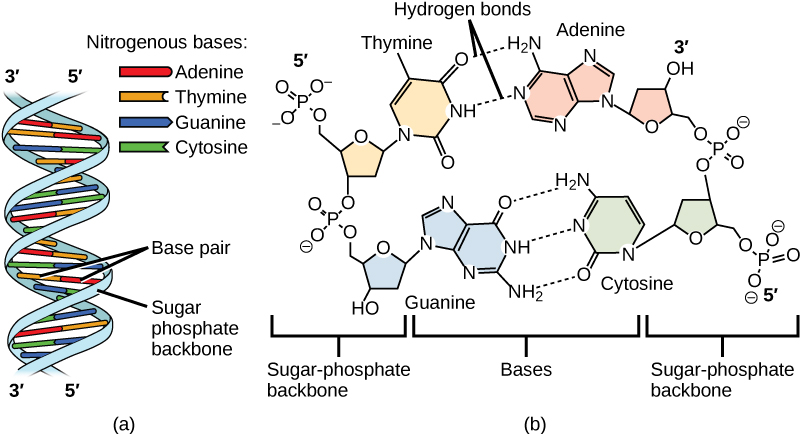
The Structure of RNA
At that place is a second nucleic acid in all cells called ribonucleic acid, or RNA. Like Dna, RNA is a polymer of nucleotides. Each of the nucleotides in RNA is made upwards of a nitrogenous base, a five-carbon sugar, and a phosphate group. In the case of RNA, the five-carbon sugar is ribose, non deoxyribose. Ribose has a hydroxyl grouping at the two′ carbon, unlike deoxyribose, which has only a hydrogen atom (Figure 9.5).
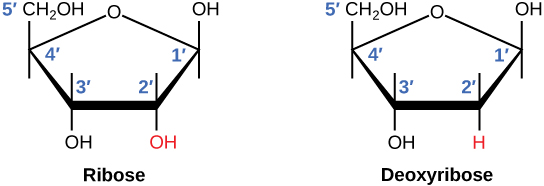
RNA nucleotides contain the nitrogenous bases adenine, cytosine, and guanine. Notwithstanding, they do not contain thymine, which is instead replaced past uracil, symbolized by a "U." RNA exists equally a single-stranded molecule rather than a double-stranded helix. Molecular biologists have named several kinds of RNA on the ground of their role. These include messenger RNA (mRNA), transfer RNA (tRNA), and ribosomal RNA (rRNA)—molecules that are involved in the production of proteins from the DNA code.
How DNA Is Bundled in the Jail cell
Dna is a working molecule; it must be replicated when a prison cell is set to split up, and information technology must be "read" to produce the molecules, such as proteins, to carry out the functions of the cell. For this reason, the DNA is protected and packaged in very specific ways. In addition, DNA molecules tin can exist very long. Stretched end-to-end, the DNA molecules in a single human cell would come up to a length of virtually 2 meters. Thus, the Deoxyribonucleic acid for a cell must be packaged in a very ordered style to fit and function within a structure (the cell) that is not visible to the naked heart. The chromosomes of prokaryotes are much simpler than those of eukaryotes in many of their features (Figure 9.6). Most prokaryotes contain a single, circular chromosome that is found in an expanse in the cytoplasm called the nucleoid.
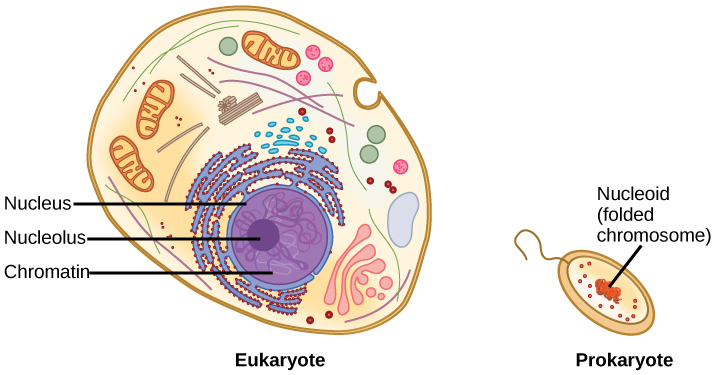
The size of the genome in ane of the most well-studied prokaryotes, Escherichia coli, is 4.6 meg base of operations pairs, which would extend a distance of near one.6 mm if stretched out. Then how does this fit inside a modest bacterial cell? The Dna is twisted beyond the double helix in what is known as supercoiling. Some proteins are known to be involved in the supercoiling; other proteins and enzymes aid in maintaining the supercoiled structure.
Eukaryotes, whose chromosomes each consist of a linear Dna molecule, use a different type of packing strategy to fit their DNA within the nucleus. At the most bones level, DNA is wrapped effectually proteins known as histones to form structures called nucleosomes. The Dna is wrapped tightly around the histone core. This nucleosome is linked to the next one past a short strand of Dna that is free of histones. This is also known as the "beads on a string" structure; the nucleosomes are the "beads" and the short lengths of Dna betwixt them are the "string." The nucleosomes, with their DNA coiled effectually them, stack compactly onto each other to form a 30-nm–wide fiber. This cobweb is further coiled into a thicker and more compact structure. At the metaphase stage of mitosis, when the chromosomes are lined up in the middle of the cell, the chromosomes are at their most compacted. They are approximately 700 nm in width, and are found in association with scaffold proteins.
In interphase, the phase of the jail cell cycle between mitoses at which the chromosomes are decondensed, eukaryotic chromosomes have 2 distinct regions that can be distinguished past staining. There is a tightly packaged region that stains darkly, and a less dense region. The darkly staining regions usually incorporate genes that are non active, and are found in the regions of the centromere and telomeres. The lightly staining regions normally comprise genes that are active, with Dna packaged around nucleosomes merely non further compacted.
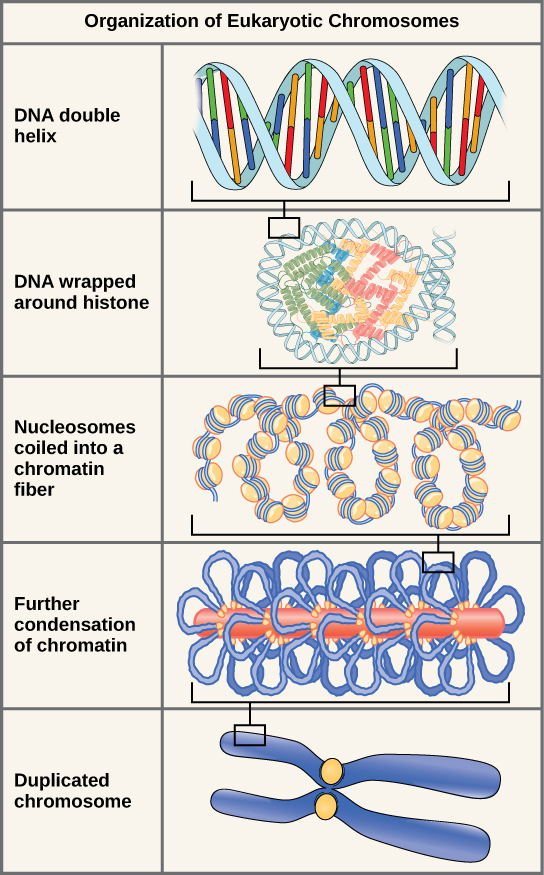
Concept in Action

Picket this animation of Dna packaging.
Section Summary
The model of the double-helix structure of DNA was proposed by Watson and Crick. The DNA molecule is a polymer of nucleotides. Each nucleotide is composed of a nitrogenous base of operations, a five-carbon sugar (deoxyribose), and a phosphate group. In that location are four nitrogenous bases in Dna, 2 purines (adenine and guanine) and two pyrimidines (cytosine and thymine). A DNA molecule is composed of two strands. Each strand is composed of nucleotides bonded together covalently between the phosphate group of one and the deoxyribose sugar of the adjacent. From this backbone extend the bases. The bases of one strand bond to the bases of the second strand with hydrogen bonds. Adenine e'er bonds with thymine, and cytosine always bonds with guanine. The bonding causes the two strands to screw around each other in a shape called a double helix. Ribonucleic acrid (RNA) is a second nucleic acid institute in cells. RNA is a single-stranded polymer of nucleotides. Information technology also differs from Dna in that it contains the saccharide ribose, rather than deoxyribose, and the nucleotide uracil rather than thymine. Various RNA molecules part in the process of forming proteins from the genetic code in DNA.
Prokaryotes contain a single, double-stranded circular chromosome. Eukaryotes contain double-stranded linear DNA molecules packaged into chromosomes. The Deoxyribonucleic acid helix is wrapped around proteins to form nucleosomes. The poly peptide coils are further coiled, and during mitosis and meiosis, the chromosomes become even more profoundly coiled to facilitate their move. Chromosomes take 2 distinct regions which tin be distinguished past staining, reflecting dissimilar degrees of packaging and determined by whether the DNA in a region is existence expressed (euchromatin) or non (heterochromatin).
Glossary
deoxyribose: a five-carbon saccharide molecule with a hydrogen cantlet rather than a hydroxyl group in the 2′ position; the saccharide component of DNA nucleotides
double helix: the molecular shape of Deoxyribonucleic acid in which two strands of nucleotides wind effectually each other in a screw shape
nitrogenous base of operations: a nitrogen-containing molecule that acts equally a base; oft referring to one of the purine or pyrimidine components of nucleic acids
phosphate group: a molecular grouping consisting of a central phosphorus atom bound to four oxygen atoms
henthornleame1972.blogspot.com
Source: https://opentextbc.ca/biology/chapter/9-1-the-structure-of-dna/
0 Response to "what are the bases and letter used to represent each base in dna."
Post a Comment